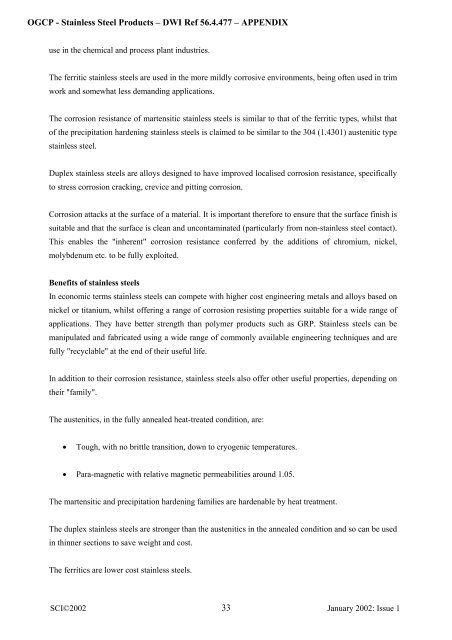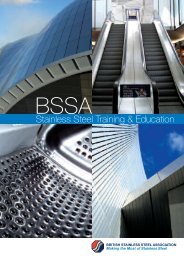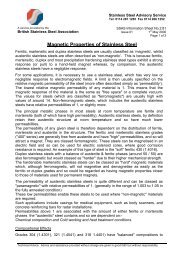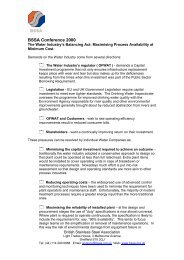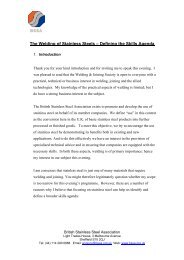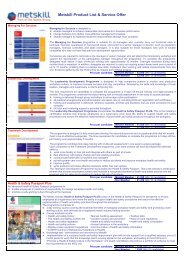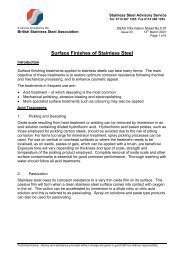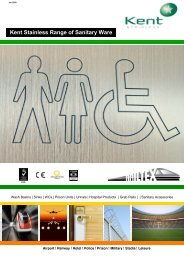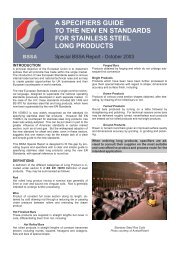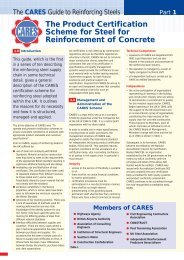Operational guidelines and code of practice for stainless steel
Operational guidelines and code of practice for stainless steel
Operational guidelines and code of practice for stainless steel
You also want an ePaper? Increase the reach of your titles
YUMPU automatically turns print PDFs into web optimized ePapers that Google loves.
OGCP - Stainless Steel Products – DWI Ref 56.4.477 – APPENDIX<br />
use in the chemical <strong>and</strong> process plant industries.<br />
The ferritic <strong>stainless</strong> <strong>steel</strong>s are used in the more mildly corrosive environments, being <strong>of</strong>ten used in trim<br />
work <strong>and</strong> somewhat less dem<strong>and</strong>ing applications.<br />
The corrosion resistance <strong>of</strong> martensitic <strong>stainless</strong> <strong>steel</strong>s is similar to that <strong>of</strong> the ferritic types, whilst that<br />
<strong>of</strong> the precipitation hardening <strong>stainless</strong> <strong>steel</strong>s is claimed to be similar to the 304 (1.4301) austenitic type<br />
<strong>stainless</strong> <strong>steel</strong>.<br />
Duplex <strong>stainless</strong> <strong>steel</strong>s are alloys designed to have improved localised corrosion resistance, specifically<br />
to stress corrosion cracking, crevice <strong>and</strong> pitting corrosion.<br />
Corrosion attacks at the surface <strong>of</strong> a material. It is important there<strong>for</strong>e to ensure that the surface finish is<br />
suitable <strong>and</strong> that the surface is clean <strong>and</strong> uncontaminated (particularly from non-<strong>stainless</strong> <strong>steel</strong> contact).<br />
This enables the "inherent" corrosion resistance conferred by the additions <strong>of</strong> chromium, nickel,<br />
molybdenum etc. to be fully exploited.<br />
Benefits <strong>of</strong> <strong>stainless</strong> <strong>steel</strong>s<br />
In economic terms <strong>stainless</strong> <strong>steel</strong>s can compete with higher cost engineering metals <strong>and</strong> alloys based on<br />
nickel or titanium, whilst <strong>of</strong>fering a range <strong>of</strong> corrosion resisting properties suitable <strong>for</strong> a wide range <strong>of</strong><br />
applications. They have better strength than polymer products such as GRP. Stainless <strong>steel</strong>s can be<br />
manipulated <strong>and</strong> fabricated using a wide range <strong>of</strong> commonly available engineering techniques <strong>and</strong> are<br />
fully "recyclable" at the end <strong>of</strong> their useful life.<br />
In addition to their corrosion resistance, <strong>stainless</strong> <strong>steel</strong>s also <strong>of</strong>fer other useful properties, depending on<br />
their "family".<br />
The austenitics, in the fully annealed heat-treated condition, are:<br />
• Tough, with no brittle transition, down to cryogenic temperatures.<br />
• Para-magnetic with relative magnetic permeabilities around 1.05.<br />
The martensitic <strong>and</strong> precipitation hardening families are hardenable by heat treatment.<br />
The duplex <strong>stainless</strong> <strong>steel</strong>s are stronger than the austenitics in the annealed condition <strong>and</strong> so can be used<br />
in thinner sections to save weight <strong>and</strong> cost.<br />
The ferritics are lower cost <strong>stainless</strong> <strong>steel</strong>s.<br />
SCI©2002 33<br />
January 2002: Issue 1


